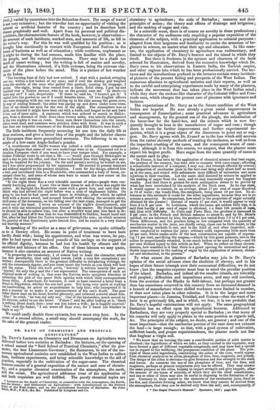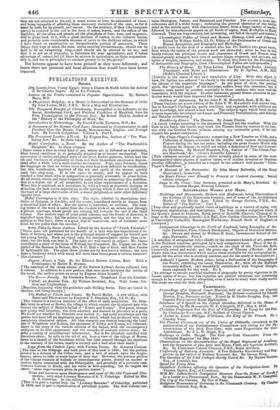DR. DAVY ON CHEMISTRY AND TROPICAL
AGRICULTURE.* Da. DAVY'S Lectures on Chemistry and Discourses on Agriculture were delivered before two societies at Barbados : the lectures, on the opening of a school named the "Reid School of Practical Chemistry," after its pro- moter, the late Lieutenant-Governor ; the discourses, to one of the nu- merous agricultural societies now established in the West Indies to collect facts, institute experiments, and bring scientific knowledge to the aid of Practice, especially in the cultivation of the sugar-cane. The chemical lectures consist of a general exposition of the nature and uses of chemis- try, and a popular chemical examination of the atmosphere, the earth, and the ocean. The agricultural addresses treat of the application of and both requisites are well fulfilled. The purely chemical topics are * Lectures on the Study of Chemistry, in connexion with the Atmosphere, the Earth, and the Ocean: and Discourses on Agriculture : with Introductions on the Present State of the West Indies, and on the Agricultural Societies of Barbados. By John
bar:, P.R.S., &c. dr.c. Published by Longman and Co.
chemistry to agriculture; the soils of Barbados ; manures and their principles of action ; the theory and effects of drainage and irrigation; and the making of sugar and rum. In a scientific sense, there is of course no novelty in these productions ; the character of the audiences only requiring a popular exposition of the elements of the subject, with a practical application to colonial purposes : adapted from their largeness and familiarity to excite the attention of be- ginners in science, no matter what their age and education. In like man- ner, the application of chemistry to agriculture was rudimentary, and limited to the objects of Dr. Davy's hearers and the island in which they dwell. But there is freshness in the aptness and clearness of the facts selected for illustration, derived from the extensive knowledge which Dr. Davy owes to his observations in Eastern India, the Turkish empire, and other regions into which he has been professionally carried. The lec- tures and the introductions prefixed to the lectures contain many incident- al pictures of the present feeling and prospects of the West Indian. The numerous allusions to agricultural societies and their reports, as well as to the careful and enterprising experiments made by many of the planters, indicate the movement that has taken place in the West Indian mind; while they show the cuckoo-like character of the Colonial Office and Free- trade cant, which charges the present race of planters with ignorance and laziness.
The expectations of Dr. Davy as to the future condition of the West Indies are hopeful. He sees already a great social improvement in consequence of Emancipation ; some practical advances in agriculture and management, by the general use of the plough, the substitution of the horse-hoe for the hand-hoe, and the science which is now fre- quently brought to bear in the manufacture of sugar and rum ; though there is room for further improvement and further experimental in- quiries, which it is a great object of the discourses to point out or sug- gest. Dr. Davy agrees with Dr. Evanst as to the loss which still accrues from the rather slovenly methods of treating the molasses, as well as from the imperfect crushing of the canes, and the consequent waste of cane- juice; although it is from this source, we suspect, that the planter must expect his largest profit. More sugar from the same quantity of canes is the surest card to play.
"In France, it has been by the application of chemical science that beet-sugar, the produce of the country, has been able to compete with cane-sugar; affording a remarkable instance of a conquest, I may say, and triumph effected by science; the proportion of saccharine juice in the beet-root being only about half as much as in the cane, and mixed with substances more difficult of extraction and more injurious in their reaction. Let the same skill directed by science be applied to the making of sugar from the cane, and we may reasonably expect the happiest results. And that there is ground for such anticipation seems to be proved by what has been ascertained by the analysis of the fresh cane. In its ripe state, it would appear to contain, on an average, about 17 per cent of sugar dissolved in 73 of water ; the woody fibre, the receptacle, being about 10 per cent. No al- lowance in this estimate is made for the other ingredients, because they are in so minute a quantity. In comparison, how small is the proportion of sugar actually obtained by the planter I Instead of nearly 17 per cent, it would appear to vary from 3 to 8 per cent. In Louisiana, where the canes are seldom fully ripe, it IA said that hardly 3 per cent of sugar is obtained, i.e. from 100 pounds of cane, ,1110..,Aiiat with difficulty. In Cuba and Porto Rico, the,produae is insreaseci to lief cent; in the French and British felonies to aboute5; and brAr..Shieria method, we are informed by him, the produce has varied from 7.3 to 8.1 per cent. These differences, and the produce being so low compared with the quantity of saccharine matter in the juice, are chiefly owing, there can be little doubt, to the manufacturing methods in use, and to the kind of, and often imperfect, mill- power employed to express the juice; ordinary mills expressing little more than 50 per cent, whilst steam-mills of the best construction are capable of express- ing 71 per cent, sacrificing the megass,—which by this great pressure, unless the action be proportionally retarded, is too much broken to be used as fuel,—and 65 per cent without injury to this article as fuel. When we reflect on these circum- stances, how manifest is it that there is a great opening for economical and pro- fitable improvement in the making of sugar by the application of science, chemi- cal and mechanical, to the process."
To what extent the planters of Barbados may join in Dr. Davy's opinion of the social advance since the abolition of slavery, and in his hopes of their future triumph over their economical difficulties, we do not know ; but the sanguine expecter must bear in mind the peculiar position of the island. Barbados, and indeed all the smaller islands, are tolerably well peopled ; difficulties and impositions arose, and may still continue, from the aversion of the Blacks to field-labour, but perhaps not greater than has sometimes occurred in this country from an increased demand in a branch of manufacture where skilled workmen were limited in number, or than now takes place in other colonies. It is in the larger and more important places—in Jamaica, Trinidad, and Guiana—that the want of la- bour is so grievously felt, and to which, we fear, it is too probable that Dr. Davy's hopeful vaticinations will not apply. The same geographical limitation has an effect upon his agricultural lectures. Addressed to Barbadians, they are very properly special to Barbados ; so that many of his remarks will only apply to places in the same position as regards soil, &c. The principles of the subject, no doubt, are general ; and one of the moat important—that the saccharine portion of the cane does not exhaust the land—is large enough; so that, with a good system of cultivation, sufficient bands, and proper superintendence, the planter needs not fear that bugbear a virgin soil.
" We know that on burning the cane a considerable portion of solid matter is obtained; the ingredients of which we infer, as they existed in the vegetable, may have formed a part of different vegetable compounds, and may have had a special use in regard to the wellbeing, the prosperous condition of the plant. The prin- cipal of these solid ingredients, constituting the ashes of the cane, would appear from chemical analysis to be silica, phosphate of lime, lime, magnesia, and potash. Thedesign of the silica is obvious—to give firmness and due strength to the stalk and leaves. As concerns the use of the phosphate of lime, and the lime, and magnesia, perhaps at present conjectures only can be offered. They may answer the same purpose as the silica, helping to impart strength and give support, after- the manner of the bones of animals, of which they are the chief constituents; and one or other of them may also be useful in disposing to the formation of su- gar. Contrary in their nature to the elements of the saccharine juice, fixed in the fire, and therefore forming ashes, we know that they cannot be derived from the atmosphere, that they can be derived only from the soil; and, consequently, if t " The Sugar Planter's Manual." Spectator, 1847 ; page 858.
they are not returned to the soil, it must sooner or later be exhausted of them; and being incapable of affording these necessary materials of the cane, so far it toast be unfit for its growth, and barren. On the contrary, if they (the inorganic parts) be restored to the soil in the form of ashes, leaves, and the refuse of the all the silica and potash, all the phosphate of lime, lime, and magnesia, will be given back to it, with a great increase of carbon in the unburut leaves, and probably some considerable increase of azote in the distillery refuse, in which I have found on examination no inconsiderable portion of ammonia. These things duly kept in mind, the cane, under existing circumstances, should not be held to be an exhausting crop,—and should not be allowed to be so; and that it is not so of necessity, is fortunate for your agriculture; and if taken advantage of, cannot fail (if there be science in agriculture, as there unquestion- ably is, and use in principles) to conduce greatly to its prosperity."
The lectures appear to have been printed as they were delivered ; and hence there are personal and local allusions that would have been better removed.



























 Previous page
Previous page